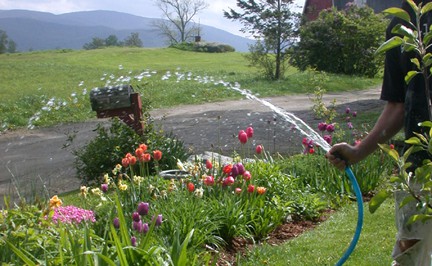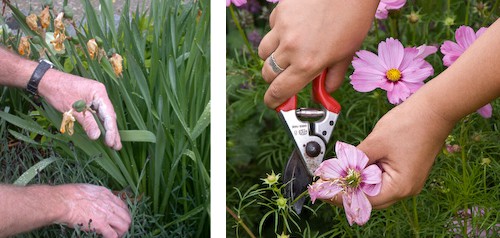More tips to keep you on the right track in the garden:
Chapter Two: The Don’ts of fertilizer application, watering, and deadheading.

Too much fun and not enough actual watering with the garden hose. Photo: Erica Bowman.
Inspired by Oliver Bell Bunce’s 1884 book “Don’t; A Manual of Mistakes and Improprieties More or Less Prevalent in Conduct or Speech,” offering etiquette advice for the early American, here are a few more pages from my own contemporary garden guide:

Perhaps a slight exaggeration, but you get the idea! Photo: Lake County Stormwater Management Commission.
1. DON’T add fertilizer without doing your research first. Some have a habit of adding fertilizer willy-nilly without understanding anything about the needs of the soil and plants. This is not only wasteful, but can be extremely harmful to the ecosystem and especially to the soil itself. Too much fertilizer can actually burn the plant or run-off into streams, ponds, and aquifers! I have seen many a well-meaning gardener completely obliterate a newly planted garden by blindly over-fertilizing. Just as when adjusting the pH, research should preclude adding anything to the soil. The local extension service (usually found at the state university) will most often do soil analysis for a fee and provide specific fertilizer recommendations for your soil and plant type. If you have already established your garden and just want to give it a springtime boost, a top dressing of well composted plants or manure can do the trick. Place it near but not touching the bases of the plants. If bagged fertilizer is just your style, I recommend an organic granular like Pro-Gro 5-3-4 from North Country Organics.

Wasting water on the leaves. Photo: Erica Bowman.
2. DON’T water the plant carelessly. It is important to realize that water acts like a magnifying glass to the sun on delicate little plants leaves and the plants will literally burn from this. You should take care to never get water on the leaves. When you water, you should do so in the early morning (before 10am) or early evening (after 4pm but before sundown) and be careful not to wet the leaves when doing so. This can be best achieved by using a long handled wand with an on/off switch at the handle. Circle the plant a few times with water, watering it at the root, and then move on to other plants to give the water time to soak in. You will need to return and water the plant again until the soil is of a consistent moist density to the depth of your finger. It is often surprising to people how long this takes and as a result plants often remain under-watered. I sometimes take two or three passes on one garden before I reach the desired moisture content – which is time consuming. This is why it is better to switch to drip irrigation after a planting bed has been established and keep it on a timer. Mulch helps retain moisture as does a good loamy soil composition.

L: Deadheading daffodils; R: Clipping cosmos. Photo: L: Erica Bowman; R: Geolicious: deadheading.
3. Don’t skip the deadheading. Jerry Garcia may be gone, but the gardens bloom on. Removing spent blossoms and seed heads (aka “deadheading”) can lengthen the period of bloom in many flowering perennials. It can also help restore order and beauty to the rest who need an after bloom clean-up. It would behoove the new gardener to learn how to deadhead each plant in his or her garden. Some plants like to be cut down to the basal growth (catmint, geraniums.) Others like to be cut back to a budding fork in the stem (beebalm, shasta daisy, coreopsis). Roses like to be cut back to a stem that contains a minimum of five leaves. Don’t be too quick to remove the foliage from perennial bulbs like daffodils, however. The plant actually reabsorbs the nutrient energy from these stems and stores it in the bulb for next year’s bloom. As a rule of thumb, do remove the spent flower head stalk but don’t cut back the daffodil leaves until they wilt. At that point, they will most likely come off with an easy tug. This is why you should plant bulbs amongst plants that will quickly grow and cover any wilting foliage.
Coming up in Chapter 3: Don’t kill your soil, Don’t write off roses, and Don’t plant mint in your vegetable garden!






good advice for the beginning of the season. I love being reminded of the don’ts to think about in the coming season when i’m about to find space for the annual seedlings i started too many of and hope they’ll prosper. Thanks Ann Carton
great reminders about watering. It is true that many people don’t realize what a proper watering should be and the time it takes done with a hose. At the same time i find it very enjoyable, therapeutic valuable time to think.
Thank you! I am enjoying all the tips…keep it coming…love it!
Dear Anne,
Some people, when faced with the same problem, have seedling/seed swaps where they invite friends and share the bounty. I also heard of a more “subversive” idea of “guerilla gardening” in which people surrepticiously planted sunflower seeds in abandoned lots across the city. Just think of the beauty you could spread with your seedlings!
More on guerilla gardening: http://www.guerrillagardening.org/
I love the pictures of hands deadheading…might have to steal the idea for my column..assuming you don’t mind.
This is some great advice for both beginners and intermediates who need a quick brushing up. I’ve seen many times customers watering their plants with a hose at full strength, practically washing the soil right out from under the plants. Light, evenly dispersed watering is the key. No garden enjoys a heavy downpour. Thank you for the post.
This is very great advice for all who need a quick brushing up for their garden. How To Design A Garden Water Feature? Can you please grant me some advice if you have some time…thanks for the great post.:-)
Great post. I’ve learned a lot. Thanks for guiding me through this. I will surely follow it. Keep posting.
-seff-